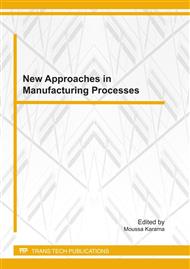[1]
V. Shenoy, I.A. Ashcroft, G.W. Critchlow, A.D. Crocombe. Fracture mechanics and damage mechanics based fatigue lifetime prediction of adhesively bonded joints subjected to variable amplitude fatigue. Engineering Fracture Mechanics, Volume 77, Issue 7, May 2010, Pages 1073-1090.
DOI: 10.1016/j.engfracmech.2010.03.008
Google Scholar
[2]
M. Quaresimin, M. Ricotta. Life prediction of bonded joints in composite materials. International Journal of Fatigue, Volume 28, Issue 10, October 2006, Pages 1166-1176.
DOI: 10.1016/j.ijfatigue.2006.02.005
Google Scholar
[3]
Gordon Kelly. Quasi-static strength and fatigue life of hybrid (bonded/bolted) composite single-lap joints Composite Structures, Volume 72, Issue 1, January 2006, Pages 119-129.
DOI: 10.1016/j.compstruct.2004.11.002
Google Scholar
[4]
M.P. Wnuk. Structural integrity of bonded joints. Physical Mesomechanics, Volume 13, Issues 5-6, September-December 2010, Pages 255-267.
DOI: 10.1016/j.physme.2010.11.006
Google Scholar
[5]
Volkersen, O. (1938). Die Nietkraft Verteilung in Zugbeanspruchten mit Konstanten Laschenquerschritten, Luftfahrtforschung 15, 41-47.
Google Scholar
[6]
Demarkles, L. R. (1955). Investigation on the use of rubber analogue in the study of the stress distribution in riveted and cemented joints, NASA TN3413.
Google Scholar
[7]
Goland, M. and Reissner, E. (1944). The stresses in cemented joints, J. Applied Mechanics 11, A17-A27.
DOI: 10.1115/1.4009336
Google Scholar
[8]
Hart-Smith, L. J. (1973). Further developments in the design and analysis of adhesive-bonded structural joints, Douglas Aircraft Co. Report 6922.
Google Scholar
[9]
Oplinger, D. W. (1991). A layered beam theory for single lap joints, U. S. Army Materials Technolgy Laboratory, Report # MTL TR 91-23.
Google Scholar
[10]
Tsai, M. Y. and Morton, J. (1994a). An evaluation of analytical and numerical solutions to the single-lap joint, Int. J. Solids Structures 31, 2537-2563.
DOI: 10.1016/0020-7683(94)90036-1
Google Scholar
[11]
Allman, D. J. (1977). A theory for elastic stresses in adhesive bonded lap joints, Quaterly J. Mechanics and Applied Mathematics 30, 415-436.
DOI: 10.1093/qjmam/30.4.415
Google Scholar
[12]
Bigwood, D. A. and Crocombe, A. D. (1989). Elastic analysis and engineering design formulae for bonded joints., Int. J. Adhesion and Adhesives 9, 229-242.
DOI: 10.1016/0143-7496(89)90066-3
Google Scholar
[13]
Bigwood, D. A. and Crocombe, A. D. (1990). Non-linear adhesive bonded joint design analysis., Int. J. Adhesion and Adhesives 10, 31-41.
DOI: 10.1016/0143-7496(90)90025-s
Google Scholar
[14]
Adams, R. D. and Mallick, V. (1992). A method for the stress analysis of lap joints, J. Adhesion 38, 199-217.
DOI: 10.1080/00218469208030455
Google Scholar


